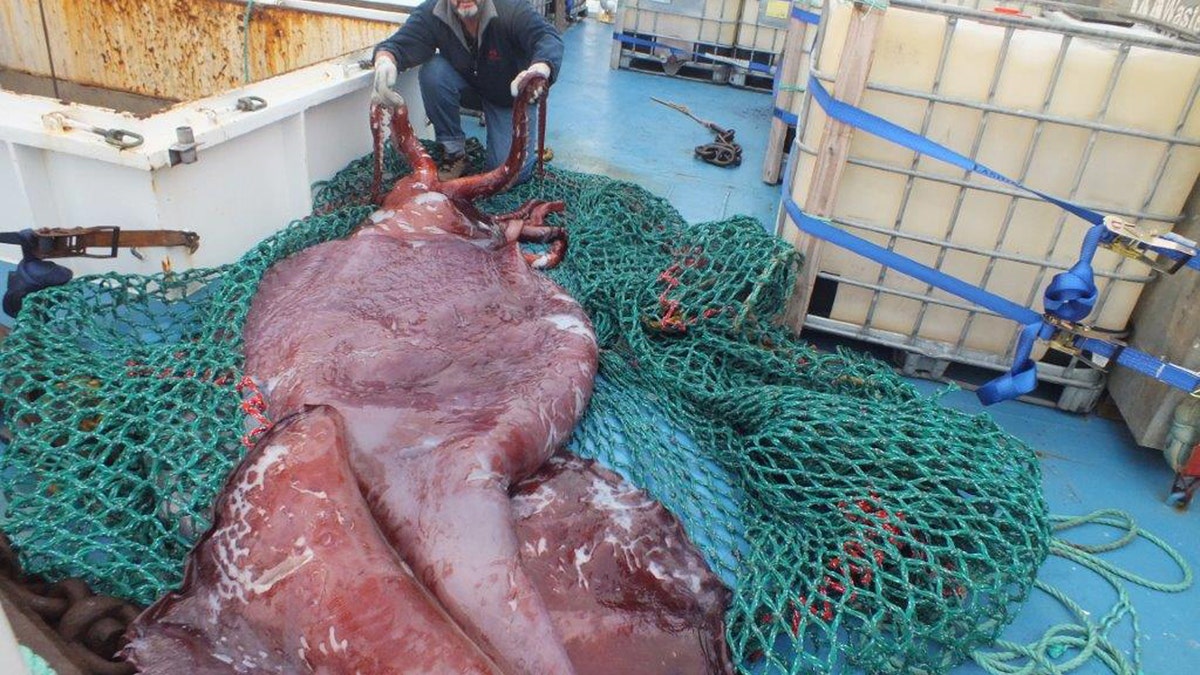
A crew member of the boat San Aspring of New Zealand fishing company Sanford, Capt. John Bennett shows a colossal squid he and and his crew caught on the boat in Antarctica's remote Ross Sea. (AP Photo/San Aspring)
Back in December 2013, Capt. John Bennett and his fishing crew reeled in an unexpected catch in Antarctica’s Ross Sea – a 770-pound colossal squid. With dinner plate-size eyes and over 3 feet-long tentacles, the giant mollusk is one of the sea’s most elusive creatures. The female squid was carrying eggs when its body was discovered, and it is only the second intact specimen ever found, reports the Daily Mail. After the discovery, the squid was placed in cold storage for eight months until Sept. 15, when a research team out of New Zealand’s Auckland University of Technology thawed out the giant sea dweller and dissected it live on camera. The massive squid had quite the audience, with its dissection streamed live by to an audience of about 142,000 people from 180 countries, according to the Associated Press.
“This is essentially an intact specimen, which is almost an unparalleled opportunity for us to examine,” Kat Bolstad, a scientist from the New Zealand research team, told the Associated Press. “This is a spectacular opportunity.”
Not to be confused with its other massive cousin, the giant squid, the colossal squid is much heavier – giant squid are believed to weigh as much as 600 pounds versus the colossal squid’s 1,000 pounds. The more famous giant squid – immortalized by Jules Verne as the inspiration for the tentacled monster in 20,000 Leagues Under the Sea – is longer and thinner.
The colossal squid has been known to scientists since 1925, with parts of their remains found in sperm whales’ stomachs, reports Vox.com. Despite coming across these small remnants of the creatures, no one had seen an intact specimen until 2003, when a fishing boat off the coast of Antarctica caught a juvenile squid. Ironically, it was Bennett and his crew that caught the first intact adult in 2007, and the rare specimen now has a home on display at the Museum of New Zealand Te Papa Tongarewa.
For researchers, finding intact specimens of these mysterious creatures sheds light on life down in the ocean’s more unreachable depths. Susan Waugh, senior curator at the museum, told the Associated Press that researchers can learn about where the animal sits in the food chain as well as more about how these animals live and die.
Will the study of these creatures shed light on those rumored epic deep sea battles between sperm whales and massive squid? Will researchers unlock the truth behind legends of the deep sea kraken that provided inspiration for many an ocean myth?
Bolstad cautioned that those stories might be nothing more than old wives’ tales.
“On the other hand, we don’t really know what the grog rations were like at that time at sea, either,” she told the Associated Press. “So it may be that we’ve got a bit of a fisherman’s story going on there, too.”
